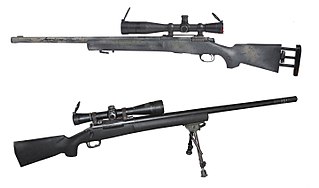
A sniper rifle is a high-precision, long-range rifle. Requirements include high accuracy, reliability, and mobility, concealment, and optics, for anti-personnel, anti-materiel and surveillance uses by military snipers. The modern sniper rifle is a portable shoulder-fired rifle with either a bolt action or semi-automatic action, fitted with a telescopic sight for extreme accuracy and chambered for a high-ballistic performance centerfire cartridge.
The Heckler & Koch PSG1 is a semi-automatic sniper rifle designed and produced by the German company Heckler & Koch.

The .338 Lapua Magnum is a Finnish rimless, bottlenecked, centerfire rifle cartridge. It was developed during the 1980s as a high-powered, long-range cartridge for military snipers. Due to its use in the War in Afghanistan and the Iraq War, the cartridge has become widely available.
The Accuracy International Arctic Warfare rifle is a bolt-action sniper rifle designed and manufactured by the British company Accuracy International. It has proved popular as a civilian, police, and military rifle since its introduction in the 1980s. The rifles have features that improve performance in extremely cold conditions without impairing operation in less extreme conditions.
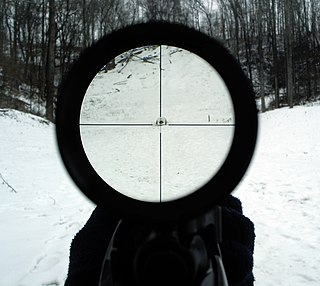
A telescopic sight, commonly called a scope informally, is an optical sighting device based on a refracting telescope. It is equipped with some form of a referencing pattern – known as a reticle – mounted in a focally appropriate position in its optical system to provide an accurate point of aim. Telescopic sights are used with all types of systems that require magnification in addition to reliable visual aiming, as opposed to non-magnifying iron sights, reflector (reflex) sights, holographic sights or laser sights, and are most commonly found on long-barrel firearms, particularly rifles, usually via a scope mount. Similar devices are also found on other platforms such as artillery, tanks and even aircraft. The optical components may be combined with optoelectronics to add night vision or smart device features.
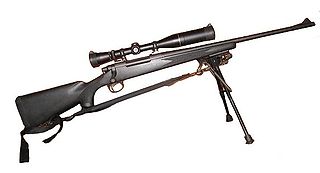
The Remington Model 700 is a series of bolt-action centerfire rifles manufactured by Remington Arms since 1962. It is a development of the Remington 721 and 722 series of rifles, which were introduced in 1948. The M24 and M40 military sniper rifles, used by the US Army and Marine Corps, respectively, are both based on the Model 700 design.

The Bor is a Polish bolt-action 7.62×51mm NATO and .338 Lapua Magnum caliber sniper rifle. The weapon received the code name Alex during development, after the name of the lead designer Aleksander Leżucha, creator of the 12.7×99mm NATO Wilk anti-materiel rifle. After the development phase, the rifle received the military designation 'Bor'.
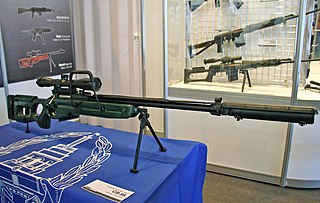
The SV-98 is a Russian bolt-action sniper rifle designed by Vladimir Stronskiy. In 2003 special operations troops were armed with the 7.62 mm 6S11 sniper system comprising the SV-98 sniper rifle and 7N14 sniper enhanced penetration round. The rifle has been used in combat during operations in Chechnya and Ukraine.
The Sako TRG is a bolt-action sniper rifle line designed and manufactured by Finnish firearms manufacturer SAKO of Riihimäki. It is the successor to the SAKO TR-6 target rifle, and thus the letter G within the rifle's name is meant to represent number 7.
EXACTO, an acronym of "Extreme Accuracy Tasked Ordnance", is a sniper rifle firing smart bullets being developed for DARPA by Lockheed Martin and Teledyne Scientific & Imaging in November 2008.
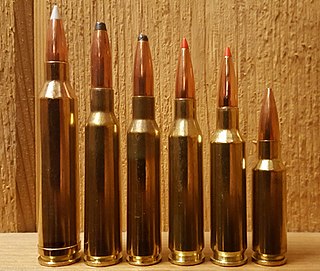
The 6.5mm Creedmoor (6.5×48mm), designated 6.5 Creedmoor by SAAMI, 6,5 Creedmoor by the C.I.P. or 6.5 CM or 6.5 CRDMR for short, is a centerfire rifle cartridge introduced by Hornady in 2007. It was developed by Hornady senior ballistics scientist Dave Emary in partnership with Dennis DeMille, the vice-president of product development at Creedmoor Sports, hence the name. The cartridge is a necked-down modification of the .30 Thompson Center.

The APR is a bolt-action sniper rifle designed by the Thun-based Brügger & Thomet in 2003 as an evolution of the French PGM Précision.
The Barrett Model 98B is a bolt-action sniper rifle chambered in .338 Lapua Magnum and manufactured by Barrett Firearms Manufacturing. The Model 98B was officially announced in October 2008, and became available for sale in early 2009, with an MSRP of $4,495.00.

The .338 Norma Magnum is a cartridge first introduced in 2008 and came into production in 2009, designed by Norma of Sweden.
The Haskins Rifle, also known as the RAI 300(Research Armament Model 300) or Haskins M500 rifle was a bolt-action weapon designed by Jerry Haskins between 1981 and 1982 for snipers in the US Military. Unlike most military sniper rifles, the Haskins was purpose-built for the military, not reworked from an existing civilian firearm.
The M2010 Enhanced Sniper Rifle (ESR), formerly known as the XM2010 and M24 Reconfigured Sniper Weapon System, is a sniper rifle developed by PEO Soldier for the United States Army. It is derived from and replaced the M24 Sniper Weapon System, and was designed to give snipers longer range in the mountainous and desert terrain of the War in Afghanistan. After winning a competitive bidding process, Remington was awarded the production contract for up to 3,600 weapons. The Army had anticipated sending the upgraded weapons to deployed snipers in late 2010, but later expected fielding would happen in January 2011. The M2010 fires .300 Winchester Magnum (7.62×67mm) ammunition, which offers about 50 percent more effective range than the M24's 7.62×51mm NATO. This chambering to dimensionally larger cartridges is possible because the M24 was designed to use the "long action" bolt version of the Remington 700 receiver for cartridges up to 3.34 inches (84.84 mm) in overall length.
The Modular Sniper Rifle, or MSR, is a bolt-action sniper rifle developed and produced by Remington Arms for the United States Army. It was introduced in 2009, and was designed to meet specific United States Army and USSOCOM Precision Sniper Rifle requirements. The MSR initially won the PSR competition, and was called the Remington Mk 21 Precision Sniper Rifle in U.S. military service. However, it was then decided that the Mk 21 did not conform to SOCOM requirements at the time in 2018, and the program was re-competed with the Barrett MRAD selected in 2019 as the Mk 22 Advanced Sniper Rifle solution.
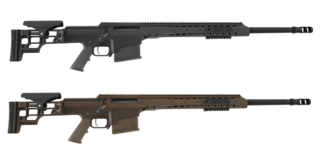
The Barrett MRAD is a bolt-action sniper rifle designed by Barrett to meet the requirements of the SOCOM PSR. The MRAD is based on the Barrett 98B and includes a number of modifications and improvements. The Barrett MRAD was named the 2012 Rifle of the Year by Shooting Illustrated magazine.
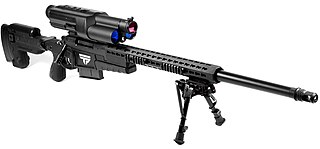
Precision guided firearms (PGFs) are long-range rifle systems designed to improve the accuracy of shooting at targets at extended ranges through target tracking, heads-up display, and advanced fire control. Inspired by missile lock-on and fighter jet technology, the application of PGF technology to small arms mitigates multiple sources of marksman error including mis-aim, trigger jerk and shot setup miscalculation. PGFs can significantly increase first shot success probability (FSSP) out to extreme ranges of 1,100 meters or more.

Long range shooting is a collective term for shooting disciplines where the distance to target is significant enough that shooter has to put effort into calculating various ballistic factors, especially in regards to the deviating effects of gravity and wind. While shooting at shorter ranges, a shooter only has to slightly adjust the sights to compensate for limited bullet drop at most, but when the range is extended, wind drift will be the first factor affecting precision to the extent that it must be taken into serious account. Some would argue that long range shooting starts where assessment of wind, distance and various atmospheric conditions are equally important for the results as pure shooting skills - meaning that even if one conducts a technically perfect shot, the shooter will miss the target because of incorrect calculations, neglecting to take some elements into consideration, or merely due to unpredictable downrange conditions. It is widely accepted within interdisciplinary circles that for a standard rifle firing full-powered cartridges, "long range" means the target is more than 600 m (660 yd) away,, while "extreme long range" is generally accepted as when the target distance is more than 1,000 m (1,100 yd) away from the shooter.












